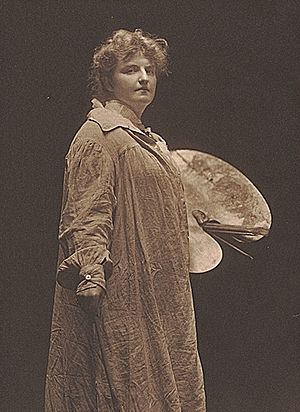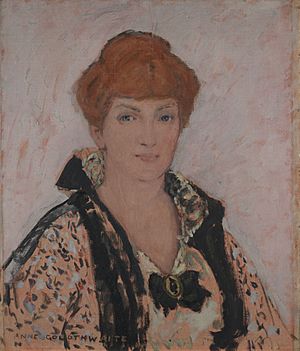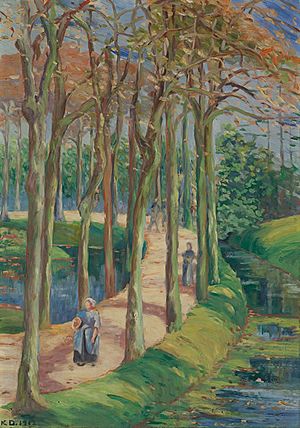Katherine Sophie Dreier facts for kids
Quick facts for kids
Katherine Sophie Dreier
|
|
|---|---|

Photograph of Katherine Sophie Dreier, 1910
|
|
| Born | September 10, 1877 |
| Died | March 29, 1952 (aged 74) |
| Nationality | American |
| Education | Pratt Institute, Walter Shirlaw |
| Known for | Abstract art |
Katherine Sophie Dreier (September 10, 1877 – March 29, 1952) was an American artist, teacher, and a big supporter of the arts. She was also a social reformer, working to improve society.
Katherine became interested in art when she was young. Her wealthy parents encouraged her to study art in the United States and Europe. Her sister, Dorothea, who was also a painter, studied with her in Europe. Katherine was very inspired by modern art, especially by her friend Marcel Duchamp.
She noticed that many people didn't understand or appreciate new art. This made her want to help other artists. She helped start the Society of Independent Artists and the Société Anonyme. The Société Anonyme created the first permanent collection of modern art in the U.S. It featured works from 175 artists and over 800 pieces of art. This amazing collection was later given to Yale University. Katherine's own art was shown in Europe and the U.S., including the famous 1913 International Exhibition of Modern Art.
Katherine was also a strong supporter of women's rights. She was a delegate at a big women's suffrage meeting in Sweden in 1911. In 1915, she led the German-American Committee of the Woman Suffrage party in New York City. She also helped run a group her mother started called the German House for Recreation of Women and Children. Her sisters, Mary Dreier and Margaret Dreier Robins, were also important social reformers.
Contents
Katherine's Early Life and Family

Katherine Sophie Dreier was born in Brooklyn, New York, on September 10, 1877. She once said she felt connected to the famous painter Peter Paul Rubens because they shared the same birth month, centuries apart. She believed she inherited some of his energy and love for color.
Her parents, Theodor and Dorothea Dreier, were immigrants from Germany. Theodor was a successful businessman. The family lived in a brownstone house in Brooklyn Heights, New York.
Katherine had an older brother and three older sisters. Two of her sisters, Mary Elisabeth and Margaret, fought for women's right to vote and for better working conditions. Her sister Dorothea was a painter who used bright colors and bold brushstrokes. The Dreier family was very close and supportive. Katherine felt especially close to Mary.
Her parents believed in giving their daughters the same chances as their son. They were also very involved in their community. Katherine started taking art lessons at age 12. She also went to a private school in Brooklyn.
From a young age, Katherine helped with social and charity causes. In 1900, her mother started the German House for Recreation of Women and Children. Katherine volunteered there as treasurer for nine years. In 1905, she helped create the Little Italy Neighborhood Association in Brooklyn and became its president. Five years later, she became one of the first directors of the Manhattan Trade School for Girls. This school trained young women for jobs.
In 1911, while in London, Katherine met and became engaged to American painter Edward Trumbull. They married in Brooklyn that August. However, Katherine soon found out that Edward was already married. The marriage was quickly ended, and she returned to London.
Katherine was financially secure. She received an inheritance after her parents passed away in the late 1890s. This allowed her to pursue her passions.
Katherine's Art Education
Katherine studied art from 1895 to 1897 at the Brooklyn Art School. In 1900, she studied with her sister Dorothea at the Pratt Institute.
In 1902, she traveled to Europe for two years with her sister Dorothea. There, they studied the works of Old Masters, who were famous artists from earlier centuries. When she came back, Katherine took private lessons from painter Walter Shirlaw. He taught her the basics of art and encouraged her to express herself.
Later, in 1907, Katherine studied in Paris with Raphaël Collin. In 1912, she spent time studying under Gustaf Britsch in Germany. She felt he was the best teacher she ever had.
Katherine's Art Career and Support for Modern Art
In 1905, Katherine painted an altar piece for a chapel in Garden City, New York. In 1909, she moved to Chelsea, London, England. This area was known for famous writers and artists. She met many artists there.
After her brief marriage ended in 1911, Katherine returned to England. She had a solo art show in London that month. In 1912, she had another show in Frankfurt, Germany. While in Germany, she saw many works by Modernist artists. She became very interested in modern abstract painting.
Her first art show in the United States was at the MacBeth Gallery in New York. Katherine showed two oil paintings at the famous 1913 Armory Show. These were Blue Bowl and The Avenue, Holland. She was upset that many people didn't respect this new kind of art. Artists like Wassily Kandinsky and Marcel Duchamp greatly influenced her work. You can see this in her 1918 painting, Abstract Portrait of Marcel Duchamp. This painting showed her move towards modern art.
Through art collector Walter Arensberg, Katherine met many new and exciting artists. In 1916, she helped start the Society of Independent Artists in New York City. Marcel Duchamp was a key figure in this group. Katherine became his friend and supporter. She showed two of her own works in their first exhibition in 1917.
In 1914, after the Armory Show, Katherine started the Cooperative Mural Workshop. She wanted to bring art and craft together. This group painted murals, held exhibitions, and offered workshops.
In 1920, Katherine, Marcel Duchamp, and Man Ray started the Société Anonyme. They wanted to "study and promote modern art." This included styles like Cubism, Expressionism, Dadaism, Futurism, and Bauhaus art. Katherine was the main force behind this group. She provided financial support and worked hard to promote it.
The Société Anonyme held its first exhibition in April 1920. After that, it promoted artists through lectures, exhibitions, and publications. They showed works by artists like Paul Klee, Wassily Kandinsky, and Joan Miró. The Société Anonyme created the first permanent collection of modern art in the United States. It had over 800 works from 175 artists.
In 1926, Katherine organized a major modern art exhibition at the Brooklyn Museum. This was the first big show of its kind in America since the Armory Show. It happened three years before the Museum of Modern Art even existed! She even bought a painting by Piet Mondrian for the exhibition.
Katherine wrote a book called Western Art in the New Era, published in 1923. It shared her ideas about modern art. She believed art should express inner spiritual meaning. In the 1930s, she gave lectures at different schools. In 1933, a show of her own art was held in New York. That same year, her book Shawn the Dancer, about her friend Ted Shawn, was published. Her abstract paintings, inspired by music, were shown in a 1935 exhibit called "40 Variations."
Katherine was always helping other artists. She helped them get publicity and became their patron, offering financial support. In 1941, Duchamp and Dreier gave the Société Anonyme's art collection to Yale University. In 1950, they published a catalog of these works. The organization officially ended on its 30th anniversary in 1950.
Later Years
Katherine's health began to get worse around 1942. But she kept working, giving lectures and writing. She passed away on March 29, 1952, in Milford, Connecticut.




